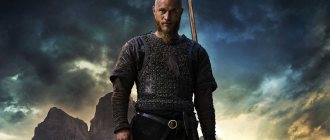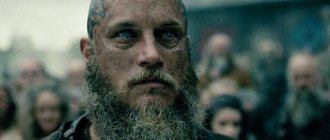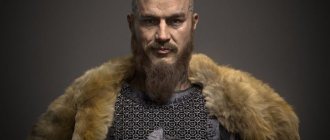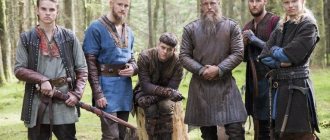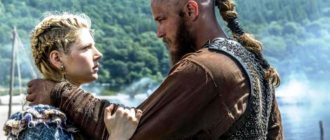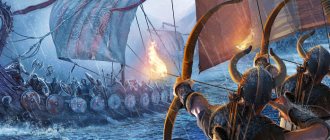Is Ragnar Lothbrok real or just a myth?
Yes, he's real. However, the question of who Ragnar really was is a matter of debate among historians. At this point, a better question would be "how close is History Channel's Ragnar to an actual historical figure?"
Although he is known as the father of some of the most famous Viking heroes such as Ivar the Boneless and Bjorn Ironside (who eventually became even more successful and famous than their father), there are several theories about the real identity of Ragnar Lothbrok
Some historians have suggested that the stories telling us of the legendary deeds of Ragnar Lothbrok are actually a compilation of stories about several different Viking historical figures, and there may be several Viking warlords who may have inspired the sagas.
How did the sixth season of “Vikings” turn out: Winter Russians against summer Norwegians
In the sixth season of the historical hit “Vikings” about the glorious Ragnar and his sons, there was a “breakthrough” - Russian actor Danila Kozlovsky starred. He played the role of Prince Oleg, who for some reason was popularly nicknamed the Prophetic.
The new season begins from the moment when, in snowy Rus', which has shrunk to the size of Kiev, which in turn has shrunk to the size of two Kizhi churches, one of Ragnar’s offspring, the rebellious Ivar the Boneless, who fled Kattegat after the murder of his brother Sigurd, is captured. Ivar, under guard, consisting of horsemen dressed as Mongol-Tatars, is brought to Oleg, who is interested in the unusual captive, the son of the great Viking, who is not a stranger to Oleg, because the prince considers himself a Viking. Here the men immediately have a rivalry - whose “sword” is longer, the god Ivar or the soothsayer Oleg. Oleg demonstratively executes several of his subordinates in front of Ivar, and Ivar looks at him with a sly Leninist squint, saying, come on, come on, I’m still the god among us. As it soon turns out, the prophet has his own plans for God - he wants to conquer the lands of Norway and install “his” Ivar as king there.
Prince Oleg (left) was played by Danila Kozlovsky
But that’s later, but for now you can fly in a hot air balloon to the fear of the Kyiv public.
Meanwhile, in Norway, things continue as usual. Lagertha buries her sword in the ground, wanting to spend the rest of her life in the wilderness in the earthly cares of her grandmother, raising two grandchildren, leaving Ubbe on the throne. Hvitserk drinks bitters, trying to forget his beloved Tora, who was burned alive, and Bjorn acquires a second wife, fortunately in tolerant Norway this is not forbidden. And he also tells everyone that it’s enough to fight, it’s time to engage in trade.
There was never agreement among Ragnar's children
But, as King Olaf said, Vikings are Vikings to fight and be at war, even if only with each other. There will be no quiet life until all the small kings unite under the rule of the supreme king.
Bjorn never became king of Norway
Bjorn goes to the rescue of Harald, who is in Olaf's captivity, where the old man lays out his plan to Ragnar's son - he, Bjorn, should become the supreme commander-in-chief, and Olaf will support him in every possible way and even renounce his kingship. Björn demonstrates the wonders of Norwegian democracy, saying that more candidates are needed for the position in order for the victory to be fair. Let’s at least take off Harald’s shackles, wash him off, and let him run for the run too. The cunning Harald approves of the plan and also promises all his support to Bjorn.
But his words are just flattery that clouds the mind of the bearded Bjorn. While he is basking in bed with his two wives, Harald persuades everyone to vote for him, a man of the people, and not some descendant of Raganar, of whom everyone is tired.
E2, E-4, checkmate, Bjorn suffers a crushing defeat.
Having become the king of all Norway, Harald immediately decides to help the women enslaved by the previous kings and sets his sights on one of Bjorn’s wives. There's no point in having two when he has none!
While big politics is happening, robber Vikings come to the wilderness of Lagertine, who do not share the intentions of the First Shield Maiden to engage in wars. They kill settlers, women and children, including Lagertha's grandson. Wounded, she arrives in Kattegat, where she is met by Hvitserk, who is high on mushrooms. The guy with red eyes has long seen only Ivar and the burnt Tora, so he mistakes Lagertha for one of them, and plunges his blade into the monster’s stomach several times.
This is how Lagertha finds her end, who was once told that she would be killed by one of Ragnar’s sons...
And it’s still Winter in Kyiv! When is summer in Norway? Here it becomes clear that Oleg’s desire to capture Norway, a warm country like Thailand, where you can soak in the warm water when the winter months are frosty in Rus'.
National Russian pastime, unheard of in Norway
Christian Oleg (who for some reason accepted the faith 100 years before the Baptism of Rus') continues to drag his crippled guest everywhere, who has gradually become accustomed to the Russian cold and even released Oleg’s disgraced brother Dir from his cage to freedom. So that he, apparently, will soon become his assistant when the Prophet becomes completely mad. In the meantime, both pretend to be “friends.” Oleg gathers an army that looks suspiciously like the Darkness of the Golden Horde (which appeared in Rus' about 300 years later), and makes the first test raid on Norway (why?), the news of which immediately spreads throughout the kingdoms. Which, naturally, gather an army to defend their native land. Ivar indulges Oleg in everything, still squinting slyly, which hints at “a possible stab in the back.”
Russians are coming!
Although the new season continues the traditions of the first, in intrigue, unexpected endings, colorful battles, the finale of the entire saga is clearly visible on the horizon. It’s not even because the creators of the series strive to complete all the storylines in the time allotted to them, but because of the fatigue of everyone who took part in the creation of the coolest historical saga all these six years. Dialogues have become simple, character actions are ill-conceived, and episodes abound
Ragnar Lothbrok: Raids on France and England
In medieval literature, stories about Ragnar Lothbrok vary in detail, however the part about his raids on France and England is almost identical in each story.
In addition to this, a chronological account of time considered to be a highly reliable source, the Anglo-Saxon Chronicle comprehensively describes the deeds of Ragnar Lothbrok, which had a significant impact on 9th-century history.
The records of the Vikings in the Anglo-Saxon Chronicle do not end with Ragnar Lothbrok. It contains some stories about his sons and how they carried on his legacy.
According to the stories of French historians, Ragnar ruled as king in Denmark and he and his sons mercilessly plundered France.
Another tale links Ragnar to Reginherus, a Viking who attacked Paris, hanged 111 Christians, and died of illness shortly afterwards.
Ragnar Lothbrok became famous as a military leader and made a fortune by raiding lands and kingdoms in the West. He allegedly attacked people while they were praying in churches.
Ragnar was known as a witty leader and sometimes used blitzkrieg (surprise attack) tactics to surprise the well-organized and disciplined forces of his enemies, especially during his attacks on France.
As the main target of his raids, France suffered greatly at the hands of Ragnar Lothbrok and his northerners. It is said that Ragnar and his men captured Paris and forced King Charles to pay 7,000 pounds as ransom.
Ragnar Lothbrok - the legendary Viking king
Ragnar Lothbrok is a semi-mythical character. Scientists are still arguing about its existence. As a historical figure, Ragnar Lothbrok does not appear in the annals, but the Norse sagas indicate that he was a very real person.
If you believe the sagas, Ragnar was a representative of the glorious family of Ynglings, descending from the god of sunlight Freyr. Frey himself is the grandson of the supreme god Odin, which indirectly classifies all his descendants as blood relatives of Odin. Frey was a fairly peace-loving god who did not like to fight, and it is he who is considered the ancestor of all the kings of Sweden and Norway.
Despite the fact that Ragnar Lothbrok (thanks to the Vikings series) is considered a simple Viking who was able to “rise” to king, most likely he was the son of the famous Danish king Sigurd the Ring. Sigurd himself was the great-grandson of Skir from the Yngling family. In order to become king of the Danes, Sigurd had to completely defeat the army of King Harold Toothless. So the stories that the “simple” Viking Ragnar Lothbrok managed to become a hero who was able to conquer Paris are, to put it mildly, doubtful.
Why was Ragnar called Lodbrok?
You can learn about the biography of the Viking Ragnar from the Scandinavian sagas. He received the nickname “Lodbrok” (which means leather pants) either in childhood or after his first marriage.
The first legend tells that Ragnar was hunting in the forest as a child and accidentally fell into a hunting hole that the Vikings dug for a large animal. A lot of poisonous snakes accumulated in this pit, which immediately attacked the future Viking king. This could be the end of Ragnar's life story, if not for the thick leather pants. The snakes could not bite through them and the future “sea king” remained alive;
According to the second legend, Ragnar received his nickname thanks to the care of his wife. It was she who sewed “magic” leather pants for him as an amulet. Most likely, the pants were made of thick hide with wool, otherwise the Vikings would not have attached such importance to this detail of their leader’s clothing. The thick skin perfectly protected against cutting blows from cold weapons, so Ragnar’s wife was right in calling it an amulet against injuries.
Linguists have other theories regarding the origin of the nickname of this legendary or historical character:
Some believe that the Vikings, when they gave the nickname "Lodbrok", meant the dark green color of the pants;
Others believe that this nickname has nothing to do with clothing at all and comes from a corruption of the name of the river Lodbrick, which translates as “stream of hatred”;
Another hypothesis says that the Icelanders gave the king his nickname and it is derived from the word “leodbroga”, which means “frightening people”;
According to another version, Ragnar went into battle under a banner depicting one of the raven companions of the god Odin. His nickname was made up of two words, which together are translated as “Fateful” (lod - fate, brog - banner).
Did Ragnar have a brother Rollo?
In the popular TV series Vikings, Ragnar has a brother named Rollo. Naturally, Ragnar had more than one brother (since the kings were not known for their chastity), but Ragnar never had a brother named Rollo.
The real Rollo is a very real character, although he was born about a hundred years later than his so-called “brother” Ragnar. Rollo's biography is documented in chronicles, so he is quite a historical figure. Rollo converted to Christianity and married the king's daughter (he was forced to give him his daughter in order to rid the kingdom of the raids of the ferocious Vikings led by Rollo). He soon became king of Normandy and died at the age of 72.
Wives and children of Ragnar Londbrok
Ragnar was quite loving, and he only had three official wives. According to the tradition of that era, marriage was regarded by the Vikings as a way to raise their status and strengthen their financial position.
The first wife (whose children were not famous for anything) was the warrior Lagertha. According to legend, in order to take her as his wife, Ragnar had to fight a wolf and a bear. Only after the bear was killed did Lagertha agree to become his wife.
If you make inquiries about the female warriors of ancient Scandinavia, it becomes clear: the matter was not limited to battles with wild animals. Ragnar could only take his warrior wife by defeating her in battle.
Having become a jarl, Ragnar divorced Lagertha, using as a reason a sign supposedly sent by the gods, who first set dogs and then a bear on him. The real reason for the divorce, most likely, was Ragnar’s desire to become related to the powerful Earl Harred, whose daughter Thora he took as his wife. The second wife gave birth to Ragnar two sons and one daughter.
But Ragnar did not stop there, and leaving his second wife, he married for the third time. This time on Princess Aslaug, whose father, the legendary King Sigurd, once killed the dragon Fafnir.
From this marriage Ragnar had five children:
Bjorn Ironside;
Sigurd Snake-Eyes;
Ivar the Boneless;
Hvitserk;
Ragnhild.
The sons of Ragnar grew up to be excellent warriors, and although there is no historical evidence of the existence of the Ragnarson brothers (the Vikings did not keep records, their main historical sources were oral sagas), many indirect sources indicate that the sons of Ragnar are as real as Ragnar himself.
Ragnar's most famous son is Sigurd the Serpent in the Eye, whose grandson later became King of Norway. Sigurd received his nickname either because of a rare mutation in his pupil, or (more likely) because of the look that no one could bear. Together with their brother Ivar the Boneless, they were considered the most cruel sons of Ragnar.
It is believed that Ragnar had at least 11 children from official marriages alone. In addition, he was not distinguished by marital fidelity, and throughout Scandinavia he had many illegitimate descendants. Many stories about how he captured women by cunning serve as confirmation of this.
The most striking example is the legend of how Lodbrok dressed in a woman’s dress in order to secretly make his way to a peasant’s daughter. This would not be unusual if this story took place in France or Italy. However, for the Vikings, being like a woman meant bringing shame upon yourself. A true Scandinavian pagan would never wear a woman's dress. Most likely, this legend is a kind of metaphor that suggests that for the sake of women, Ragnar was ready to cross any moral standards of those times.
Ragnar's Great March into the Lands of the Franks
Ragnar most likely would not have achieved historical fame if not for his victory over the Franks. The illiterate barbarian was able to capture Paris, defeating the strongest army in Europe at that time.
Ragnar was driven to war with the Franks by the fear that after his death there would be heroes who could surpass the great warrior. Because of this, Lodbrok took on the most incredible adventures and campaigns. Possessing incredible leadership abilities, Ragnar emerged victorious from the most difficult situations. That is why his luck attracted Viking robbers from all over Scandinavia to campaign against the lands of the Franks when Ragnar set off for the shores of France in 845. About 150 ships with 5,000 Vikings on board set sail with him. Although such a gang was extremely difficult to control, Ragnar's authority and cruelty were able to unite them into one powerful force.
As soon as the army reached France, it split into two parts to plunder as much land as possible until the inhabitants fled inland to escape the ruthless pagans. Ragnar's troops went along the Seine River, and the second part, led by Hasting (lodbrok's faithful friend) - along the Loire. Plundering the surrounding villages, cities and monasteries, the Vikings soon reunited into one army with the goal of capturing Paris.
The Frankish king Charles the Bald prepared a trap for the northern invaders by placing his army on both banks of the Seine. But this trick turned against him. The Viking horde of Ragnar and Hasting crushed half of the Frankish army with a lightning strike, and the other half simply could not help them.
To avoid a dangerous battle with the surviving half of the Frankish army, Ragnar gave the order to kill all the Franks in sight of the enemy. The Vikings, being recognized as masters of shoulder work, hanged more than a hundred enemies, and quartered and tortured the rest. The Franks retreated to Paris in horror, and Charles the Bald soon agreed to pay off in order to save the city from plunder.
On March 28, the Viking army solemnly entered Paris. Charles the Bald had to pay a huge ransom. True to his word, Ragnar did not touch Paris, but soon returned again and plundered all the settlements on the banks of the Seine. The king placed a huge reward on Ragnar's head, but no one dared to take such an adventure.
There is an opinion that the capture of Paris by the Vikings was not so much the merit of Ragnar as a happy accident. The Franks at that time were considered the best warriors in Europe, had better armor and weapons, and were also hardened in constant military skirmishes. On the other hand, the Frankish army was weakened by an internecine war initiated by the three sons of Louis, who were unable to peacefully share their father’s throne. Most likely, Ragnar knew this: in addition to the fact that he had military leadership talent, he did not disdain the services of hired spies.
The Frankish army did not come to a consensus on which contender for the throne to support. Therefore, she was simply not ready to repel the lightning strike of the daring and battle-hardened northern robbers. In support of this point of view, it would be appropriate to recall that the previous Viking campaigns on the lands of France were not as successful and were more like predatory raids.
The second Viking campaign ended in failure, as most of the northerners were out of action due to dysentery. The invasion was similar to an ordinary Viking raid, and this time only monasteries and villages were plundered.
There is one interesting fact regarding Ragnar Lothbrok. In Europe they called him “The Scourge of God.” Ragnar received this nickname for the special cunning with which he conquered Christian cities. Having waited for a church holiday or at least Sunday, Ragnar watched when all the knights gathered in the church, after which he easily captured the city and the unarmed warriors blocked in the temple.
Despite the fact that the Vikings usually sacked cities and killed everyone, Ragnar was more practical in this regard. He forbade burning the city and killing its inhabitants if they agreed to pay a ransom. Ragnar told his warriors that they could return in a few years to this same place and again take rich booty. And that's what he usually did.
Death of Ragnar Lothbrok
When Ragnar's children were already adult warriors, he decided to repeat his legendary feat by capturing the kingdom. This time he chose Northumbia. This campaign turned out to be unsuccessful for the old king. The warriors of King Aella captured Ragnar and put him to a painful execution in a pit with poisonous snakes. There are several versions of why Ragnar's army lost this battle:
According to the first version, the Viking fleet was caught in a storm and was almost completely destroyed, and the surviving Vikings were easily finished off by the soldiers of the English king. Considering the Vikings' experience in navigation, this option is quite difficult to believe;
According to the second version, the ship with Ragnar, sailing off the coast of Northumbia, ran aground and drowned. Lodbrok, who emerged, was easily captured;
The third version is striking in its arrogance, but knowing the character of Ragnar, one can easily believe in it. Ragnar went to Northumbia for ransom on a single ship. He was so confident in his abilities that he did not even imagine that he would be killed. Captured, Ragnar arrogantly demanded his immediate release and payment of a ransom for the insult that King Aella had inflicted on him.
Dying from the bite of a poisonous snake, Ragnar said (in the hope that these words would be told to his sons) the following words: “My piglets will grunt when they find out about the death of the old boar!” It is not known whether these words were true or whether the skalds added them, but the sons of Ragnar really brutally executed King Aelle, who killed their father.
Revenge of the sons of Ragnar Lothbrok
Upon learning of their father's death, the Ragnarson brothers were seized with noble rage. Their father died as a slave; he was not even given a weapon, thereby depriving him of the opportunity to get to Valhalla. Having gathered an army of thousands, they set out on a great campaign against the lands of the British. In 867, the united army of Ragnar's sons invaded Northumbia, immediately defeated Ella's army, and he himself was put to a painful execution.
Not satisfied with this, the brothers moved on and ravaged most of England. This fact has been historically confirmed and is called the “Great Pagan Army,” although some historians doubt that the death of Ragnar Lothbrok was the reason for the start of Danish expansion.
The Viking invasion lasted 4 years and was stopped by King Alfred, who received the title “Great” during his lifetime.
Bonus: Video about Ragnar Lothbrok.
(c) ULFHED
Sons, daughters and wives of Ragnar Lothbrok
Ragnar Lothbrok had three wives: Lagertha, a maid, Aslaug, a warrior queen, and Thora-Hart (Borgarhjort), a noblewoman, daughter of Count Gerraud of Götaland. It should also be noted that some reports mention a fourth wife.
Ragnar's wives gave him many sons, the most famous of whom were Bjorn Ironside, Ubba (Ubbe/Hubba/Justo), Hvitserk (Hvitserkr), Halfdan Ragnarsson/Halfdan Ylving and Ivar the Boneless (Invar/Ingvar).
If you would like to know more about the story of Bjorn Ironside, check out the following post: Bjorn Ironside, Son of Ragnar Lothbrok
If you want to know more about the real historical figure, Ivar the Boneless, read here: Ivar the Boneless, Son of Ragnar Lothbrok - The True Story
Erik, Agnar, Hastein, Rognvald, Harald and Fridleif/Fridleif Ragnarsson (his son by Shieldmaiden Lagertha), Danvath Ragnarsen and Radbard Ragnarsen are other names recorded as sons of Ragnar Lothbrok.
Ragnar had two daughters with Lagertha the maid and several daughters with his other wives, but there is no exact information about their names. Only two names, Ragnhild Ragnarsdottir and Olof Ragnarsdottir, appear in some reports as possible names for his daughters.
Ragnar Lothbrok and Lagertha
While there aren't many resources detailing who Lagertha really was, there is one that may shed some light on the shieldmaiden's life: Gesta Danorum ("deeds of the Danes").
The Gesta Danorum tells that Ragnar met Lagertha while he was taking Norway from Fre, King of Sweden, who killed Ragnar's grandfather, King Siward of Norway during the invasion.
Along with the women of King Siward's family and other courtiers, Lagertha was captured and placed in a brothel for humiliation.
These women fought bravely when Ragnar Lothbrok came to save them and reclaim his grandfather's lands. There Ragnar met Lagertha. Lagertha is mentioned in the Gesta Danorum as "a woman with the courage of a man who fought fearlessly."
According to this story, Ragnar was so impressed by Lagertha's bravery that he wanted to marry her. But it wasn't that easy. Ragnar killed the bear and dog that guarded Lagertha's house to convince her to marry.
It's interesting to note that, unlike how it was portrayed in the History Channel's Vikings, Bjorn Ironside is not listed as the son of Lagertha and Ragnar in most historical accounts. He was the second son of Ragnar and Aslug after Ivar the Boneless. Yes, Ivar is told that he is the oldest.
Lagertha and Ragnar had a son, but his name was Fridleif.
Wives and children
According to information that has reached us, Ragnar Lothbrok was officially married three times. According to established traditions, Vikings increased their fortunes and raised their social status through marriage. Having defeated a wild wolf and a ferocious bear, young Lodbrok had the opportunity to fight with the warrior Lagertha and subsequently marry her. But this marriage did not last long.
Lagertha gave birth to a son and two daughters, and Ragnar, wanting to climb the social ladder and become a jarl, divorced her and married the daughter of Jarl Harred, Thora.
Jarl in Scandinavia was originally the name of the ruler of a separate tribe, and later the ruler of the entire people.
In this marriage, Jarl Ragnar and Princess Aslaug had five sons, who left a noticeable mark not only in the history of Scandinavia, but also in the memory of the peoples they conquered. Their names were Bjorn Ironside, Sigurd Snake-Eyes, Ivar the Boneless, Hvitserk and Ragnhild. They extended the family tree and continued the work of their father.
Bjorn was called Ironside due to the fact that in numerous battles and duels he managed to avoid serious injuries. He is known as a successful conqueror of the Mediterranean and North African lands. Sigurd received his nickname due to either a mutation in the pupil - a snake was supposedly visible in it, or because of his piercing gaze. His grandson managed to take the throne of Norway.
Another colorful figure in the Lodbrok family is Ivar the Boneless. Researchers also differ in their opinions about the origin of his nickname. Some believe that he suffered from a bone disease and could not walk on his own legs. Others believe that he was named Boneless due to the extraordinary agility of this warrior. He and Sigurd were distinguished by their extraordinary cruelty and harsh character.
In addition to the mentioned eleven descendants from official marriages, the legendary Ragnar had many more illegitimate children both in Scandinavia and in the lands he conquered, the names of which history is silent about.
There is even a saga that a brave warrior could dress in women's clothing for a date with his next mistress.
Although, according to their pagan traditions, wearing a woman’s dress meant covering yourself with indelible shame. Most likely, it was meant that this hero-lover was ready to do anything to win over another woman.
Ragnar Lothbrok and Aslaug
The History Channel's portrayal of Aslug, also known as Kraka and Randalin, is more accurate compared to some of the other characters in the series.
According to the Volsunga Saga, Aslaug, the third wife of Ragnar Lothbrok, was the daughter of the legendary Norse hero Sigurd and the shield-maiden Brynhildra.
When her parents, her mother's adoptive father, died, Hymer thought it would be dangerous if anyone knew who Eslog really was. He made a large harp and carried Aslaug in it while he wandered around pretending to be a harpist. This continued until one day Ragnar Lothbrok's men discovered her while she was bathing.
Mesmerized by Aslug's beauty, Ragnar's men forgot about the bread they were baking and they had to tell Ragnar about her when Ragnar asked what happened.
Ragnar sent his men to bring Aslug to him. Wanting to make sure that she was not only beautiful, but also smart, Ragnar conducted some kind of test with her. Eslaug managed to impress him, and Ragnar asked for her hand in marriage. At this moment, Ragnar had no idea that she was the daughter of two legendary Viking heroes.
When Ragnar visited Eysteinn Beli, Viceroy of Sweden, Eysteinn convinced him to marry his daughter Ingeborg instead of Aslug. However, the birds had already informed Aslaug (who had been told that he had "powers") that Ragnar had changed his heart, and so she had to tell him the truth about her true identity.
Aslaug told Ragnar Lothbrok that she was the daughter of the shieldmaiden Brynhild and the legendary Viking Sigurd, who slew the dragon Fafnir (or the serpent) according to myth.
She told Ragnar that she would give him a child with a dragon/snake in its eye to convince him of her heritage. She succeeded as this became a reality when she eventually gave birth to Sigurd the serpent in the eye, who was born with the mark of ouroboros in his left eye.
According to legend, Aslaug also tried to warn Ragnar Lothbrok when he decided to sail to England for the last time. This was sort of depicted in the History Channel's Vikings, when Aslaug saw visions of Ragnar and Ivar falling into the sea.
On the other hand, Aslaug, known as the sorceress, supposedly enchanted Ragnar's armor, and this is why the snakes in King Aelle's pit could not kill Ragnar Lothbrok until his men removed Ragnar's armor.
Hog with his piglets
In 865, Ragnar decided to visit Britain, but on the way his fleet was caught in a strong storm and the earl's army was significantly weakened. Having attacked one of the British islands - Northumbria, the Vikings received a decisive rebuff. The pagans were defeated, and the invincible Ragnar Lothbrok himself was captured. This time the brave hero suffered a setback - his fleet ran aground and the Vikings were unable not only to advance, but even to defend themselves.
In a mysterious twist of fate, King Aella decided to execute Ragnar by throwing him into a pit of snakes! And this time, leather pants did not save the brave Viking - he died from a poisonous snake bite in the face. The last words of the legendary hero of the Scandinavian sagas were: “The piglets will grunt when they find out how the old boar died.”
As might be expected, Ragnar's descendants became angry when they learned of their father's murder and vowed to avenge him. Particularly infuriating was the fact that if their father died such a death, he would not go to Valhalla - a paradise for the Vikings. The most ferocious of his sons - Bjorn and Sigurd - gathered several thousand warriors and went on a campaign against Northumbria. As a result, the British troops were defeated, and King Ella II was brutally executed and died in agony.
The brothers destroyed and plundered a huge part of Britain, and not everyone agrees that this was done in the name of revenge. Perhaps, under such a noble pretext, the sons of Ragnar simply plundered a huge number of people in Britain for four years.
The physical death of the Scandinavian hero Ragnar Lothbrok did not erase his memory in the hearts of his compatriots.
The place where he is buried is not known for certain. To this day, March 28th is HIS day and the saga of HIS exploits is read. He became an undying hero of Scandinavian legends and myths. Residents of Scandinavia pay tribute to their ancestors and remind the whole world of their legendary heroes.
The image of Ragnar Lothbrok and his companions is reflected in many modern computer games, and TV series are being filmed about the exploits of ancient heroes. The Vikings series, which presents the main milestones in the life of the legendary hero Ragnar Lothbrok, has gained enormous popularity around the world. His role in the film was played by actor Travis Femmel. Thanks to his brilliant performance, we were presented with the image of a living and invincible Ragnar.
Ragnar Lothbrok and Rollo - brother of Lee Rollo Ragnar Lothbrok?
Stories about these times consist mainly of sagas and oral histories. As such, it is impossible to know with certainty the birth dates of the actual figures who inspired the History Channel's Vikings characters.
However, the estimated year of Ragnar Lothbrok's death is known as 840, and that is 20 years before the Viking leader known as Rollo was even born.
Rollo and Ragnar Lothbrok were not brothers, and these two historical figures lived in different times.
Some historians claim that it was Rollo and other Viking leaders who raided and captured Paris. You can read our detailed article on Rollo here: Rollo, Viking Duke of Normandy
Ragnar Lothbrok and Floki
The character named Floki in the History Channel's Vikings is based on a real historical figure named Hrafna-Flóki Vilgerðarson. But was he really Ragnar Lothbrok's best friend? This did not happen.
Floki's birth year is recorded as 830 in records, and this is only 10 years before Ragnar Lothbrok died as an old man. So, it's safe to say that Ragnar Lothbrok and Floki the Ravens ("hrafna" means "raven") probably never even met or were as close as depicted in the series.
Read more about the real historical figure, Floki Vilgerðarson here: Real Floki (Vikings), Raven/Hrafna-Flóki Vilgerðarson
How did the Vikings series end?
“Vikings” is a historical series on the History channel, the plot of which is based on the Scandinavian sagas about the deeds of the semi-legendary king Ragnar Lothbrok and his children. The first season of the show aired in March 2013 and focused on poor peasant Ragnar's first journey across the sea, the launch of raids on the English coast and the hero's rise to power in Kattegat, but in subsequent seasons the geography of events has expanded significantly. The creators of the show showed the audience not only Denmark and England of the 9th century, but also medieval Paris, as well as Arab countries, Kievan Rus, Iceland and even North America.
The events of Vikings have a mythical and historical basis, but the series can hardly be called strictly historical. After the death of Ragnar, which was colorfully described in season 4, the plot of the show focused on the real-life campaign of the Great Viking Army against the Anglo-Saxon kingdoms, but the absence of the charismatic hero Travis Fimmel significantly reduced the ratings of the following episodes. The series lasted 2 more seasons and ended in December 2022.
The latest season of Vikings is marked by the departure of characters who have been present in the show since the first episodes. Brave Lagertha decides to retire and founds a remote village in order to grow old calmly in the circle of loved ones, but White-Haired and his gang overtake the warrior. They attack Lagertha's settlement and kill her grandson, but the heroine manages to kill the enemy. Seriously wounded, she travels to Kattegat, but falls prey to the madman Hvitserk. The prediction that Lagertha will fall at the hands of Ragnar's son comes true.
Ivar persuades Oleg to lead the Russian army against Bjorn. Bjorn, who accepted the title of king and mourned his mother, expects an attack by his treacherous brother in the spring, so he teams up with Harald’s Norwegians, but the Boneless uses cunning and strikes in an unexpected place. He surrounds the Scandinavian army, defeats it and captures Vestfold. Bjorn meets Ivar on the battlefield and receives a mortal wound from his spear.
Before his death, the king manages to lead the remnants of the army and repel the further advance of the Russian army on Kattegat. Defeated, Oleg returns home and plans new wars, but becomes a victim of the intrigues of Ivar and Katerina. The prince finds death from Igor's arrow.
Ivar, having achieved the murder of Oleg, abandons the pregnant Katerina and, taking Hvitserk, goes to Kattegat. The Danes are not happy about their defecting brothers, but Ragnar's son inspires his compatriots to resume the glorious custom of raiding England.
He plans a campaign against Alfred, gathers an army and sails overseas, but the British are tired of the robbery of the Vikings. King Alfred repels the invaders and crushes the united Scandinavian army. Harald and Ivar die on the battlefield, and Hvitserk decides to accept Christ and becomes a priest. Alfred baptizes him and names him Athelstan.
Ubba decides to set off on a new voyage. He is attracted by the distant, abundant land that Ottar promised, but the travelers lose their course and end up not in America, but in desert Greenland. There Ubba and his people suffer from hunger and thirst, so they set off again and find the long-awaited Vinland. There the Vikings encounter Indian settlements and learn that some of the Indians speak Danish. It turns out that the locals learned Danish from Floki, who had arrived in Vinland earlier.
In the final scene of Vikings, Floki and Ubba sit on the ocean, watching the sunset and wondering what the future will be like.
How useful is the publication?
Click on a star to rate!
Average rating 3.7 / 5. Number of ratings: 6
No ratings yet. Be the first to rate.
Death of Ragnar Lothbrok - how did Ragnar Lothbrok die?
There are two different stories that tell us about the death of Ragnar Lothbrok. The first identifies him with Reginieri and suggests that he died of a fatal disease similar to diarrhea immediately after he devastated Paris.
The description of this disease and the manner of his death given in several reports point to dysentery as his cause of death.
The second story, told in some historical sources, particularly in the Anglo-Saxon Chronicle, tells us that Ragnar Lothbrok meets death at the hands of his enemies.
It should also be noted that this is how Ragnar's death was portrayed in The Tale of Ragnar Loðbrókar, which includes part of the Saga of the Völsungs.
According to this version, on his way home after being forced to leave Paris, Ragnar's ship washed ashore on the coast of the kingdom of Northumbria, where he had previously been repeatedly attacked and held for ransom.
Wanting revenge on Ragnar Lothbrok, King Ælla of Northumbria captured and threw Ragnar into a pit of snakes, leaving him to a painful and gruesome death.
Legend has it that just before he died, Ragnar Lothbrok sang a Norse hymn and told King Ælla that his sons would avenge him.
In some versions of this story, Ragnar said "how the little piggies would grumble when they heard how the old boar suffered" right before he died (spoiler alert is that the history channel is included in the show, as fans who already know watched season 4).
King Aella sent envoys to release the sons of Ragnar Lothbrok to kill their father, after which the sons swore to avenge their father.
The Great Viking Army, the sons of Ragnar Lothbrok, invaded England and killed King Aelle in 866.
Ragnar Lothbrok's legacy continued, and his descendants continued to influence the structure of the region even after his passing. About two centuries after his death, the descendants of Ragnar Lothbrok's sons settled on the west coast of France, turning the area into “the land of the Northmen, Normandy as we know it today.
“Vikings” season 4: episode 15 released in translation, King Aella brutally kills Ragnar
The new episode of the series “Vikings” season 4 was released in Russian translation. Watching it will upset many fans of the series. The new episode of the series contains a lot of cruelty and blood, as well as sadness, sadness and a nascent thirst for revenge.
It all begins with Ragnar saying goodbye to his son Ivar the Boneless. Finally, he gives him advice on how to continue living and, most importantly, how to avenge him. Previously, Lodbrok agreed with King Egbert that he would save him from the revenge of his sons. In exchange, he asked to release his son. However, the king himself tells Ivar that his sons should take revenge on Egbert, and not on Ella. Thus, the great Viking decided for the last time to carry out a cunning plan against the hated Saxons.
Ragnar is handed over to King Aelle in a cage. Along the way, the horses are driven by a blind driver. He turns to the prisoner and says that he sees him. This is exactly what was predicted about Ragnar's death: he would die when the blind man saw him. The cart in the forest meets with Ellie's retinue and a long bloody feast begins. Lothbrok's longtime enemy enjoys every minute of his torment. First, his cage is hung high on a tree. The king's guards poke him with spears and burn the floor with torches. Ella himself watches this during the meal and laughs joyfully. The next day, the king himself begins to torture the exhausted Viking. First he hits him. But not in a fair fight. Ragnar is held by guards while he beats him. Ella then tries to extort requests from the Viking for absolution. But loyal to Odin and his other gods, Ragnar is not going to do this.
The Viking's execution is scheduled for the next day. They dig a deep hole for him, and poisonous snakes are thrown into it. Before his death, Ragnar Lothbrok says that he is not afraid of oblivion and joyfully goes to Odin. The frightened King Egberd also came to observe his execution. He disguises himself as an old man and attends the bloody battle incognito.
Meanwhile, a ship with Ivar the Boneless on board arrives in Kattegat. And then Ubba and Siggurd take their brother. Relatives will have a difficult conversation. Ivar tells his brothers that his father has been handed over to King Ella as a prisoner. And also the fact that Ragnar is most likely already dead. And then his brothers tell him their sad news: their mother is dead. In the last episode, Lagertha shot Aslaung in the back when she had already given up and refused to fight. Ivar had the closest relationship with his mother, as she loved her youngest son more than the rest. Therefore, the news of the death of his beloved woman hurts Ivar. He tightly clutches the chess piece that Egbert's grandson gave him before leaving. This causes blood to flow from his palms.
Photo: stills from the series
Video: promo series
Ragnar Lothbrok in popular culture
As the protagonist of a historical drama series, Australian actor Travis Fimmel plays Ragnar Lothbrok in the History Channel's Vikings.
However, the historical figure portrayed in History Channel's Vikings should not be confused with the characters in BBC Two's The Last Kingdom, which is another Viking series adapted from the historical fiction of Bernard Cornwell. Both young Ragnar and his father, Ragnar the Fearless, have no relation to Ragnar Lothbrok.
Fans of The Last Kingdom may have already noticed that only Ivar the Boneless and Ubba/Ubbe are called "Lothbrokson" in The Last Kingdom. Partially based on true events, this story takes place during the time of the sons of Ragnar Lothbrok and the Great Army's invasion of England.
If you want to know more about Ragnar Lothbrok, the Sagas of Ragnar Lothbrok, translated by Ben Waggoner, includes three different texts telling the story of the legendary Dane (The Saga of Ragnar Lothbrok, The Tale of Ragnar's Sons and Segubrot, an Icelandic text about the Danish and Swedish kings) along with extensive comments and notes to supplement them.
The Armenian Genocide in Turkey - chronology of the tragedy
What does Lodbrok mean?
According to legend, the nickname Lodbrok (translated as “Leather Pants”) was given to Ragnar in his childhood. One day, while walking in the forest, he suddenly found himself in a hole. It was dug by hunters to capture wild animals. The hole was dug too long ago, because during this period many snakes crawled into it and made their home there. According to this legend, Ragnar then saved himself from imminent death thanks to tight leather pants, because the snakes were unable to bite through them.
Another version says that Ragnar's leather pants were made by his first wife Lagertha, or Lazgertha. She gave them to her husband as a talisman or amulet that was supposed to protect its owner. Some stories claim that the Danish king had to put them on before every battle, while others say that he wore them in peacetime.
Scientists and linguists are still arguing over Ragnar's nickname. Some people think that "Lodbrok" would be correctly translated as "dark green trousers." Others think that this element of clothing has no meaning. In particular, the writer and researcher Rory Mac Turk has an assumption that Lodbrok came from the distorted name of the Lodbrick river, which flows in the English county of Devonshire. This name is translated as “hating stream” or “stream of hatred”.
The eminent Icelandic historian and linguist Hermann Palsson has no doubt that "Lodbrok" is an Old English word. However, he believes that it comes from a corruption of the Icelandic "leodbroga", which can be translated as "frightening people" or "terrifying".
There is another translated nickname for Lodbrok as “The Banner of Fate.” According to this interpretation, Ragnar went to battle under a banner depicting one raven, Odin. This raven showed with its wing where Ragnar's Vikings should go.
